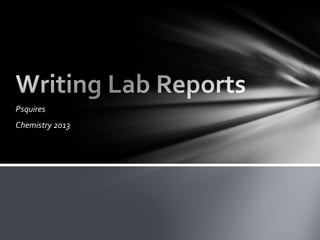
Writing lab reports
- 2. Steps to writing a lab report • Title • Materials Used • Procedure • Data/Calculations/Charts/Graphs • Conclusion
- 3. Title The title should be less than ten words. A good title is straightforward and uses keywords that researchers in a particular field will recognize. Examples: pH Lab, Density of Solids, Static Electricity, etc. Very important to have a title because you will be turning in several labs at the same time.
- 4. Materials As the name implies, the materials used in the experiments should be reported in this section. When procedures from a lab book or another report are followed exactly, you still must write what you used. Some items may change or substituted from the original paper/book. This can usually be done in a short paragraph, possibly along with a drawing of the experimental apparatus. You may also use bullets for this section Generally, this section attempts to answer the following questions: What materials were used?
- 5. Procedure Methods used in the experiments should be reported in this section. The difficulty in writing this section is to provide enough detail for the reader to understand the experiment without overwhelming him or her. Specific data or results should not be included in this section. However, it is still necessary to describe special pieces of equipment and the general theory of the assays used. This can usually be done in a short paragraph, possibly along with a drawing of the experimental apparatus. Bullets may be used in this section also.
- 6. Data, Calculations,Charts and Graphs The results section should summarize the data from the experiments. The data should be organized into tables, figures, graphs, photographs, and so on. But data included in a table should not be duplicated in a figure or graph. Not all labs will have graphs or charts….all labs will have data or calculations. All figures and tables should have descriptive titles and should include a legend explaining any symbols, abbreviations, or special methods used. Figures and tables should be numbered separately. Figures and tables should be self-explanatory; that is, the reader should be able to understand them without referring to the text. All columns and rows in tables and axes in figures should be labeled.
- 7. Conclusion This section should not just be a restatement of the results but should emphasize interpretation of the data, relating them to existing theory and knowledge. Speculation is appropriate, if it is so identified. The conclusion is the most important part of the lab write-up because it lets me know that you understood the lab. Conclusion should include: •What we did •Why we did the lab •What you learned •What errors were made or what you could have done better
- 8. Lab write-up example Volume of a solid 1. Before we start, try to define volume in your own words: (Remember, you can always change your definition later.) 2. Now, figure out a way to measure the volume of a lump of clay. Describe how you will do this below. Volume of the lump of clay: 3. Now that you’ve recorded the volume of the lump of clay, try this: change the shape of the clay. Roll it into a perfect ball, make it into a rod, poke a hole through it, shape it into a face; use your imagination! Just be sure to use the whole lump of clay. Sketch it below: 4. Before you measure the volume of this new shape, hypothesize as to whether or not the volume of the clay will change. Will it increase, decrease, or stay the same? Why? Volume of the new clay shape: 5. Did your results match your prediction (above)? Try and explain why or why not. 6. Because we just did the following experiment, we can sharpen our definition of volume. Take into account whether the volume changed once you reshaped it, and redefine the word volume below. 7. Does everything have a definite (constant) volume? If so, why? If not, name something that can have its volume changed.
- 9. Lab write-up example Title: Volume of a solid Materials: Clay, meter stick or ruler, etc Procedure: •Take a piece of clay and make a cube out of it •Find its volume using a meter stick •Record your results and plug them into a mathematical formula (volume = s 3) •Change the shape of the clay to a cylinder •Find its volume using a meter stick •Record your results and plug them into a mathematical formula ( )
- 11. Lab write-up example Conclusion: What we did We took a piece of clay and made it a shape so that we could calculate its volume. After taking a measurements with a meter stick we recorded the data and found that the cube was x. We then changed the shape of the clay and recalculated the volume. Why we did the lab We did this lab to practice calculating volume. We used various techniques learned in the classroom and math formulas to find that the volume of a solid does not change just because we change the shape. Solids do have definite shape and volume. What you learned I learned that just because you reshape a solid you do not change its volume. I learned that we can take everyday objects to prove theories. I also learned that I remembered more from Geometry than I previously thought. What errors were made or what you could have done better I could have measured more precisely or with smaller units than centimeters. I could have read the meter stick to a larger decimal. I could have used other shapes that would have been easier to take reading of and calculate. I could have made sure that I calculated correctly.